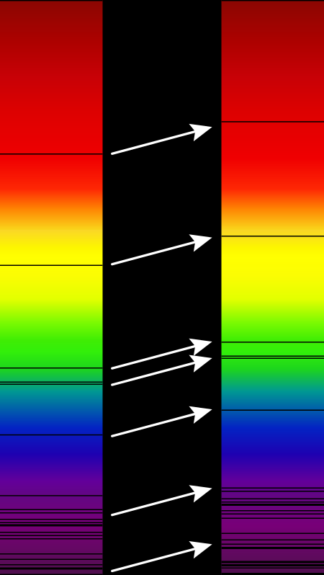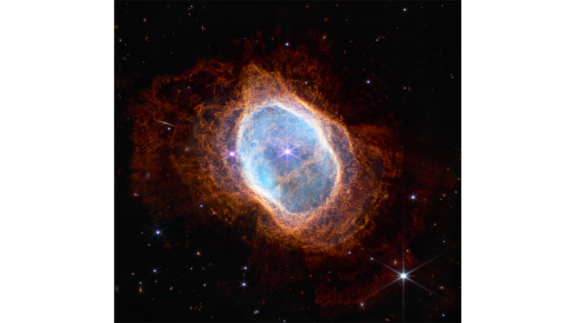On Wednesday, the Astronomy Department colloquium featured Rachel Somerville, who spoke on the investigation into the early days of the Universe using the James Webb Space Telescope.
The James Webb Space Telescope. Astronomers and astrophysicists had waited with excited fervor for its launch at the end of last year. Even the general public was widely aware of the mission, with practically everyone interested in at least looking at the photos. But what was the goal of the telescope? There are numerous projects and experiments that plan to make use of the telescope’s capabilities and data over its predicted 20-year lifespan. Dr. Rachel Somerville, Distinguished Professor and the George A. and Margaret M. Downsbrough Chair in Astrophysics at Rutgers, is working on one of the very first. At the weekly Astronomy and Astrophysics colloquium, she spoke about a question that teams around the world are looking to answer: what did our early Universe look like?

It’s clear that this is not a simple task. Even before James Webb was launched, scientists had been using other data sources, such as the Hubble and Spitzer telescopes, to try and obtain an answer. Experiments came in various forms. Some consisted of charting—counting and surveying galaxies, as well as finding their properties. Others used techniques such as SED (spectral energy distribution) to attempt to sort galaxies by their ages. One main method that emerged was photometric selection; by analyzing images and using a limit known as the Lyman break, a galaxy’s redshift can be determined. Redshift refers to the increase in the wavelength or the decrease in the frequency of the light that an object emits. In cosmology, redshift is proportional to the distance between an object and an observer. So what does this mean? Light from objects that are extremely far away has taken an immense amount of time to reach us and has undergone the largest redshift. Using this idea, we can take a look at galaxies as they were earlier in time, closer to the Universe’s formation.
Astrophysicists took models that combined various variables, including stellar mass, metallicity, and more to try to tie them together with the redshift data. This technique allowed them to learn a great deal about galaxies with a redshift of z ~ 2-4 (where z is a variable describing the wavelength change). But there are far more candidate galaxies with redshifts of z ~ 6-11, and some even have spectroscopic confirmation for their existence. Scientists hope that by pushing the limits of these experiments, they can discover more about the early Universe, including a specific phenomenon known as cosmic reionization. After the Big Bang, the Universe first fell into a time known as the “dark ages.” It was full of neutral particles, and little occurred other than cosmic background radiation. Then, about 150 million years after the Big Bang, cosmic reionization started. Photons in the Universe began to reionize the neutral hydrogen atoms that filled the Universe, leading to far more energetic activity. Cosmic reionization can be investigated by looking at objects with redshifts of z ~ 6-20, which have the appropriate ages. Scientists wish to know what sources produced those photons, how the ionized volume changed over time, and more. The James Webb Telescope was designed to answer the first of these questions.
First, before data from James Webb was available to them, astronomers sought for a long time to create a model for galaxy formation. One of the main achievements of this effort was the Lamba-CDM (cold dark matter) model. It, in short, divides the Universe into sections of dark energy, cold dark matter, and ordinary matter. Using the equations in the model, the properties of galaxies can be simulated and solved. Lambda-CDM was found to be remarkably consistent up to z ~ 10, managing to correctly fit almost all parameters (with the important exception of cosmic dust). Although higher redshift results had more variance, this model was able to tell scientists that more dense gas was leading to greater star formation, as well as other important results. Still, cosmic reionization eluded astronomers. The contributing galaxies were simply too faint to be able to be seen with the Hubble.
Finally, the star of the show is formally introduced: the James Webb Space Telescope, larger than the Hubble or Spitzer, and able to detect longer wavelengths with better resolution. After the arduous process of launching the JWST, unfolding its mirrors, and deploying the sun shields, its wide array of cameras and instruments was ready to give the astronomers what they had waited for.
Several projects jumped on the data immediately upon its release. Some programs observed the Abell 2744 galaxy cluster in an attempt to find the ages and compositions of the contained galaxies and better understand the reionization process. CEERS (Cosmic Evolution Early Release Science) was a major project, whose work involved characterizing galaxies with redshifts of z ~ 9-13. Using prior simulations to process the James Webb data, scientists obtained a wealth of results about the high redshift galaxies. Soon, every astronomer was writing their own paper about finding galaxy candidates that broke the redshift barrier. Some were true breakthroughs; others were later found to be impostors mischaracterized due to the presence of dust. Either way, the findings inevitably led to an abundance of various theories: some exciting but rather unlikely, others likely but boring, and a few that were both plausible and interesting. These suggestions included that there were lower amounts of dust found than expected, that black holes were leading to some detected radiation signals, and various other findings with large implications for their fields.

So what have we learned from Webb? Our current models for galaxy formation still remain consistent, but only up to a point. The new high redshift data is still limited but has already departed from established models in some cases. Luckily, the overall Lambda-CDM theory still remains viable for now, and the categorization of the Universe has not yet sharply changed. With the new information about high-redshift galaxies, we are also steadily approaching an understanding of what occurred during the reionization process. We are not even a year past Webb’s launch, and already the data it has provided is groundbreaking. Astronomers, astrophysicists, and even casual enthusiasts such as me all hope to see the James Webb telescope continue to work superbly and allow us to construct an even better view of the Universe.
Header via Wikimedia Commons
Redshift image via Wikimedia Commons
Nebula image via Webb Space Telescope


 0 Comments
0 Comments